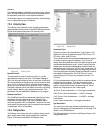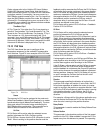
48 www.emersonct.com SM-EZMotion Module User Guide
time they activate even when a capture object is not
configured. If any of these Sources are assigned to a
destination, the captured data may be used by the
destination function.
The Destinations that can use the automatically captured
data are as follows:
• Index.#.Initiate
• Index.#.SensorTrigger
The automatically captured data is not available to the user
like it is when a capture object is used. The processor takes
care of resetting the automatic capture internally.
Index.#.Initiate - When one of the Sources listed above
(Sources That Accurately Capture Data) is assigned to an
Index Initiate, the captured information is automatically
applied to the index starting point. This offers extremely
high accuracy for initiation of motion, which is beneficial
especially in synchronized applications.
Index.#.SensorTrigger - The sensor trigger destination
used in registration indexes can use captured data to
accurately calculate the ending position of the index based
on the Registration Offset parameter. The Offset distance
is added to the captured position to let the accurate
stopping position for the registration index.
7.3.13 Queues View
The Queues View allows the user to configure the
necessary parameters for the Queue object to function
properly. Figure 79 shows an example of the Queue view.
Figure 79: Queues View
A detailed explanation of each of the queue components is
as follows:
Queue Data
The queue data is loaded into the queue by statements in
the user program. Two types of data are most often used
with the queue: Position Feedback, and Master Position
Feedback.
Queue Size
This is the maximum number of elements that can be
stored in the queue. If more than this number of pieces of
data is in the queue at a time, then a Queue Overflow
source will activate.
Queue Offset
The Queue Offset is the value that is added to the Queue
Data and then compared to the selected source to
determine when the Queue Exit event activates. For
instance, if the source in selected source is set to
Feedback Position, and the Queue Offset is set to 10, and
the user puts the value 5 into the queue, the Queue Exit
source will activate when the Feedback Position is greater
than or equal to 5 + 10 or 15.
Full Level
The amount of data in the queue is constantly monitored
and the Queue Full source will activate when the number
of pieces of data in the queue exceeds the Full Level
parameter.
Queue Full is only a flag and does not cause an error or a
trip of any kind.
Source
The Source determines which parameter the sum of the
Queue Data and Queue Offset are compared to in order to
activate the Queue Exit function. If set to Position
Feedback, the sum of the data and offset are compared to
the Position Feedback parameter. If set to Master Position,
then the sum is compared to the Master Feedback Position
parameter, and if set to Command Position, then the sum
is compared to the Motor Commanded Position.
Name
You can assign a descriptive name to each queue, making
the setup easier to follow. The length of the text string is
limited by the column width with a maximum of 12
characters.
Simply double click on the Name field of any queue to
assign a name to it.
Number of Queue Units
This selects the number of Queues available. Maximum of
eight.
Queue Sources and Destinations
Figure 80 shows a block diagram of the Queue object.


















